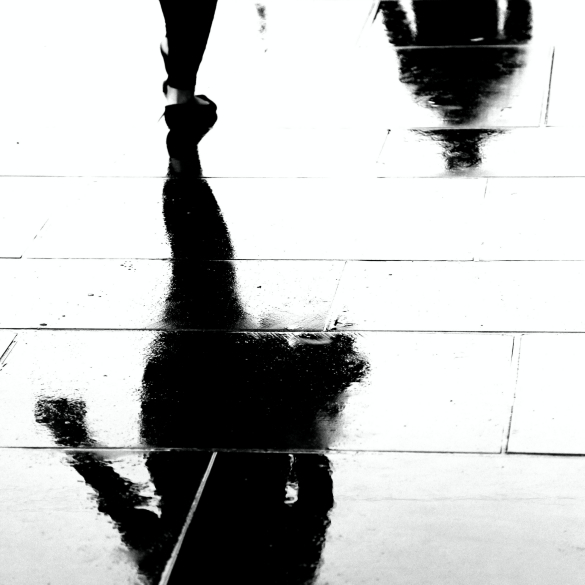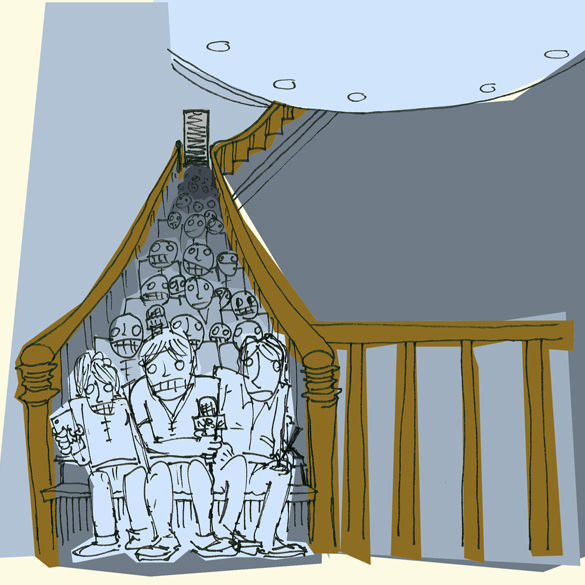Members of the Rain cast during the Sgt. Pepper period
“I think people who truly can live a life in music are telling the world, ‘You can have my love, you can have my smiles. Forget the bad parts, you don’t need them. Just take the music, the goodness, because it’s the very best, and it’s the part I give most willingly.’”—George Harrison
Even before the curtain lifts on Rain: A Tribute to the Beatles, playing now through May 2011 at the Brooks Atkinson Theater, the audience is primed for a good time. And the show, with its talented cast of four Beatles impersonators performing the songs and music live, does not disappoint. In fact, at a time when some shows are struggling to fill seats, Rain not only recouped its $2 million investment halfway through its 12-week run at the Neil Simon Theater last fall, but it also grossed more than $1.4 million in the week from Christmas to New Year’s Eve.
The cultural odyssey that is Rain begins on February 7, 1964, when the Beatles’ plane landed at JFK Airport in New York City. At the time, the Beatles’ songs filled the top five spots in the pop charts—something that has never been repeated. And two nights later, as 73 million people watched, the Beatles performed live on the Ed Sullivan Show—one of the most popular television shows of its time. For that brief moment in time, the streets emptied and crime stopped.

The Beatles’ arrival in America brought about a cultural shift in the way young people thought about everything from sex to drugs to war and peace. “Their outstanding music placed them in an unprecedented position of authority,” writes professor Henry W. Sullivan in The Beatles with Lucan (1995). “They presided over an epochal shift comparable in scale to that bridging Classical Antiquity and the Middle Ages, or the transition from the Middle Ages to the Renaissance.”
Forty years later, that influence remains undimmed. Indeed, as the audience response to Rain makes clear, what was thought to be a mere generational blip has now become a trans-generational cultural mainstay. Despite the band’s breakup in 1970, one would think the band had never broken up. Certainly, with sales of their albums dominating iTunes and their pictures emblazoned on billboards across the country, it seems as if they never left. As Nicholas Schaffner observes in his book The Beatles Forever, “The Beatles will be remembered not only for their considerable contribution as songwriters and recording artists, but also as the most remarkable cultural and sociological phenomenon of their time. During the 1960s they seemed to transform, however unwittingly, the look, sound, and style of at least one generation… more than anyone else [it was] John, Paul, George and Ringo who set in motion the forces that made a whole era what it was, and, by extension, what it is today.”
Sitting in that darkened theater, I watched the cast members of Rain change costumes, mustaches and wigs to chronicle how the Beatles evolved physically during the musical journey, all the while a trio of flickering screens set on either side of the stage projected footage of 1960s news events such as the Kennedy assassination, fashion commercials and Vietnam being carpet-bombed. For many of those assembled, it was a trip down memory lane. For others, it was an exercise in time travel back to a golden age when the Beatles’ music reflected the hopes, fears and social conscience of those who came of age in the Sixties. Most of all, however, it was a fitting reminder of how much fun the Beatles were to watch and why Beatlemania caught on so quickly. Frankly, surrounded as I was by screaming fans of all ages who spent much of the two-hour show standing, singing and dancing to the music of the Fab Four, I was hard-pressed to maintain a critical neutrality. It wasn’t long before I, too, had succumbed to the lively, infectious and just plain fun spirit of the evening.
Just as it was the Beatles’ music that propelled them into mythology, it’s the music that makes the show, and Rain, structured like an extended Beatles concert, is nothing less than a celebration of such classic Beatles tunes such as “Yesterday,” “Eleanor Rigby,” and “While My Guitar Gently Weeps,” among others. Beginning with the Beatles’ appearance on the Ed Sullivan Show and the Shea Stadium concert, which was the first mass outdoor rock concert, the concert moves along in chronological order. Songs and music from the Sergeant Pepper era follow, folding seamlessly into the White Album and Abbey Road periods. Rain also recreates some songs from the famous rooftop concert and even adds Lennon’s “Give Peace a Chance.” The group also admirably tackles songs the Beatles never played live—including such classics as “Strawberry Fields Forever” and “A Day in the Life.” Best of all, the performers re-appear on stage for a shorter set in response to the audience’s demand for an encore, closing out the show with “Hey Jude,” complete with an audience sing-along and fine vocals by Joey Curatolo.
As Steve Landes, a Rain cast member who has spent the past 13 years playing John Lennon, told the Associated Press, “I think there’s just something personal about [the Beatles’] music that touches everyone, whether it speaks of a romantic love or a greater understanding. There’s some sort of positive message—usually of peace and love and togetherness—and it hits people and it stays with them, whether they were there at the time, whether they’re just finding out about it now.” 
Thankfully, the music of the Beatles lives on, and for those fortunate enough to see Rain during its stint on Broadway, it’s a great way to spend an evening—singing, and, if you like, dancing in the aisles.


